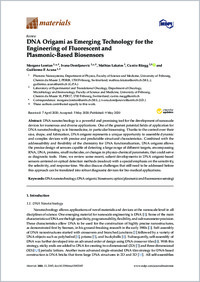DNA origami as emerging technology for the engineering of fluorescent and plasmonic-based biosensors
- Loretan, Morgane Photonic Nanosystems, Department of Physics, Faculty of Science and Medicine, University of Fribourg, Chemin du Musée 3, PER08, 1700 Fribourg, Switzerland
- Domljanovic, Ivana Laboratory of Experimental and Translational Oncology, Department of Oncology, Microbiology and Immunology, Faculty of Science and Medicine, University of Fribourg, Chemin du Musée 18, PER17, 1700 Fribourg, Switzerland
- Lakatos, Mathias Photonic Nanosystems, Department of Physics, Faculty of Science and Medicine, University of Fribourg, Chemin du Musée 3, PER08, 1700 Fribourg, Switzerland
- Rüegg, Curzio Laboratory of Experimental and Translational Oncology, Department of Oncology, Microbiology and Immunology, Faculty of Science and Medicine, University of Fribourg, Chemin du Musée 18, PER17, 1700 Fribourg, Switzerland
- Acuna, Guillermo P. Photonic Nanosystems, Department of Physics, Faculty of Science and Medicine, University of Fribourg, Chemin du Musée 3, PER08, 1700 Fribourg, Switzerland
-
09.05.2020
Published in:
- Materials. - 2020, vol. 13, no. 9, p. 2185
English
DNA nanotechnology is a powerful and promising tool for the development of nanoscale devices for numerous and diverse applications. One of the greatest potential fields of application for DNA nanotechnology is in biomedicine, in particular biosensing. Thanks to the control over their size, shape, and fabrication, DNA origami represents a unique opportunity to assemble dynamic and complex devices with precise and predictable structural characteristics. Combined with the addressability and flexibility of the chemistry for DNA functionalization, DNA origami allows the precise design of sensors capable of detecting a large range of different targets, encompassing RNA, DNA, proteins, small molecules, or changes in physico-chemical parameters, that could serve as diagnostic tools. Here, we review some recent, salient developments in DNA origami-based sensors centered on optical detection methods (readout) with a special emphasis on the sensitivity, the selectivity, and response time. We also discuss challenges that still need to be addressed before this approach can be translated into robust diagnostic devices for bio-medical applications
- Faculty
- Faculté des sciences et de médecine
- Department
- Département de Physique, Médecine 3ème année
- Language
-
- English
- Classification
- Medicine
- License
- License undefined
- Identifiers
-
- RERO DOC 328627
- DOI 10.3390/ma13092185
- Persistent URL
- https://folia.unifr.ch/unifr/documents/308731
Statistics
Document views: 89
File downloads:
- rue_doe.pdf: 267
